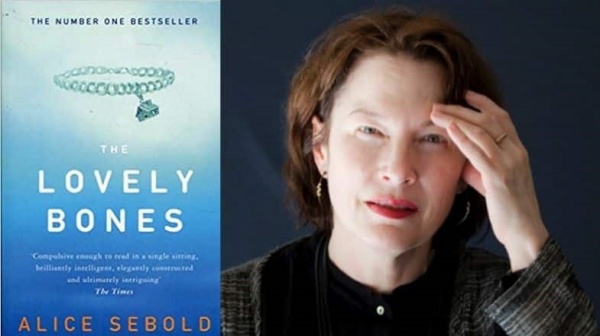Emily Horowitz’s take on the wrongful rape conviction in the Alice Sebold case
Originally published at Reason 11/29/21.
By Emily Horowitz . . . Alice Sebold’s bestselling 1999 memoir Lucky tells the story of a young woman raped by a stranger while attending Syracuse University. In the book, the rapist is caught and convicted. After writing about the experience, Sebold went on to write the bestseller The Lovely Bones, a fictional account of a teenage girl raped and killed. But last week Anthony Broadwater, the man who served 16 years in prison for raping Sebold, was exonerated.
Timothy Mucciante, a producer working on a film adaptation of Lucky, was fired after raising questions about inconsistencies in Sebold’s story. Mucciante, who has a legal background, started reviewing the police files; he became even more troubled by discrepancies between the memoir and the facts of the case, to the point where he “couldn’t sleep.” Mucciante ended up hiring a private investigator to investigate further, and the P.I. broke the case. Broadwater’s conviction turns out to have rested on shaky evidence: Sebold had had trouble identifying her assailant—she had initially picked a different man out of a lineup—and the only forensic evidence was a form of hair analysis that the government now considers junk science. Even at the time, the expert witness could only say that the attacker’s hair was “consistent” with Broadwater’s, not that it definitively was his hair.
Broadwater was placed on the New York Sex Offender Registry after his 1999 release, and he remained on it until a few days ago. His case starkly highlights the needless cruelty of sex offense registries.
Broadwater married after prison, but he never had children; he recently told the Syracuse Post-Standard that this was because he didn’t want them growing up with a father with a rape conviction. Meanwhile, the newspaper notes, he was “turned away from countless jobs and educational opportunities over the years for one simple fact: he’s a convicted rapist on the sex offender registry.” This story is familiar to the nearly one million Americans on such registries, who are well-aware that the stigma extends beyond them to their families and all those close to them. Every registrant’s photo, address, and crime are publicly posted, creating inescapable infamy and extremely limited job opportunities.
So Broadwater essentially served two sentences: one in prison, and one on the registry after his release. In New York, where Broadwater was convicted and still resides, a pending Clean Slate bill would automatically expunge criminal records after three years for misdemeanors and seven for felonies, to help those with prior convictions pass background checks to access more housing and employment opportunities. Yet it excludes sex offenses, a fact the literature promoting the bill prominently highlights.
But even the guilty don’t deserve this treatment. The consequences of these registries, detailed painfully by Broadwater and so many others, all kick in after those convicted have completed their sentences. The registries also include people convicted as minors, people convicted of statutory and noncontact offenses, and people with developmental disabilities, mental health struggles, or substance use disorders.
In his Syracuse.com interview, Broadwater said that he tried to take vocational classes after his release but was kicked off campus when administrators learned he was on the registry. Broadwater happened to be innocent, but even if he wasn’t, shouldn’t continuing education be available to those seeking stability and employment after being incarcerated?
Inside Higher Ed recently reported that increasing interest in racial justice has led to colleges “ramping up efforts to serve students currently or formerly in prison.” There is bipartisan agreement that this is a smart and ethical investment. I founded and co-direct such a program at St. Francis College. But these efforts, like New York’s Clean Slate bill, often exclude people on registries. And even when states or individual institutions do not query potential participants about their criminal histories, federal law requires that those on registries (unlike those convicted of nonsexual offenses) give notice to the state about their enrollment, often prompting a predictable administrative backlash.
One reason for sex offense “carve-outs” is due to myths about recidivism and who winds up on registries. Contrary to popular belief, those with sex offense convictions actually have lower recidivism rates than those convicted of most other offenses (a belief unfortunately fortified by the Supreme Court, which once mistakenly declared the sex offense recidivism rate “frightening and high“). It’s worth noting that about a third of the nearly 3,000 documented exonerations since 1989 involve sex crimes, even though only about 13 percent of people in prison are there for a sexual offense.
But data are no match for fear and emotion. These are reinforced by a cultural fixation on statistically rare but terrifying cases of stranger danger (even though the vast majority of sexual violence against both children and adults involves nonstrangers). And this, in turn, is reinforced by books like Sebold’s.
Reports have surfaced that Broadwater has been living in “windowless squalor,” unaware of his key role in Sebold’s memoir or the windfall and fame it brought to her. In The New York Times, Broadwater recalled “the years of stigma and isolation” he faced as a registrant. This post-prison treatment is not a recipe for safety or success. In fact, studies have shown that sex offense registries have not made America’s children any safer. The data also show a consistent, decades-long decline in child sex offenses that started prior to the implementation of registries.
It is time for things to change.
Colleges should continue to lead criminal justice reform efforts, but with new offense-blind admissions welcoming all who want to learn. And our country should no longer brand anyone who has served their time as unworthy of forgiveness or a second chance.





